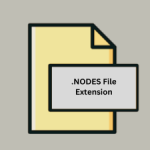.MDR File Extension

ModPlug Compressed Module
| Developer | Olivier Lapicque |
| Popularity | |
| Category | Audio Files |
| Format | .MDR |
| Cross Platform | Update Soon |
What is an MDR file?
The ‘.MDR’ file extension is primarily associated with Metadata Repository files. These files are utilized to store metadata, which is essentially data about data. Metadata can include information about file properties, such as file type, author, creation date, and more.
More Information.
The history of the ‘.MDR’ file extension is closely tied to the development of software modeling and database design tools.
Initially, it was introduced as a part of software modeling tools to facilitate the documentation of software systems. Software architects and developers used ‘.MDR’ files to define and maintain the structure of databases, making it easier to understand and manage complex data models.
The usage of ‘.MDR’ files expanded beyond pure documentation. They became instrumental in various software development processes, including code generation, reverse engineering, and system analysis. ‘.MDR’ files enabled developers to generate code automatically based on the defined data structures, streamlining the development process.
Origin Of This File.
The origin of the ‘.MDR’ file extension can be traced back to the realm of database management and software development.
It was created to serve as a standardized format for storing metadata related to various software components, such as database tables, columns, and relationships.
The purpose was to provide a means to document and manage data structures and relationships within complex software systems.
File Structure Technical Specification.
Understanding the file structure and technical specifications of ‘.MDR’ files is essential for those who work with them.
These files are typically stored in a binary format, which means they are not human-readable. The binary structure of ‘.MDR’ files is designed to efficiently store metadata in a compact and organized manner.
Technical specifications for ‘.MDR’ files can vary depending on the software tool or platform used to create and manage them. Some common elements found in ‘.MDR’ files include:
- Metadata Definitions: ‘.MDR’ files contain definitions of metadata elements, including their names, data types, and relationships.
- Data Model Information: Information about data models, such as entities, attributes, and associations, is stored in ‘.MDR’ files.
- Tool-Specific Data: Some ‘.MDR’ files may include tool-specific data related to the software modeling or database design tool used.
How to Convert the File?
Converting ‘.MDR’ files to other formats or vice versa may be necessary in certain situations. The process of conversion typically depends on the source and target formats.
Here are some common scenarios:
- Export to XML/JSON: To make ‘.MDR’ data more accessible, you can export it to XML or JSON formats using software tools that support these conversions.
- Import from Database: In some cases, you might want to import data from a database into an ‘.MDR’ file. Database management software often provides this functionality.
- Conversion to CSV: If you need to work with ‘.MDR’ data in spreadsheet software like Microsoft Excel, you can convert it to CSV (Comma-Separated Values) format.
- Using Conversion Tools: There are dedicated conversion tools available that can assist in converting ‘.MDR’ files to other formats. These tools may support various output options.
Advantages And Disadvantages.
Advantages:
- Structured Data Storage: ‘.MDR’ files provide a structured and organized way to store metadata, making it easier to manage complex data models.
- Automation: They enable automation in software development by allowing automatic code generation and analysis based on the defined metadata.
- Tool Compatibility: ‘.MDR’ files are often supported by various software modeling and database design tools, enhancing compatibility.
Disadvantages:
- Binary Format: ‘.MDR’ files are stored in a binary format, which means they are not easily readable or editable without specialized software.
- Tool Dependence: Compatibility and usability may be limited to specific software tools that support the ‘.MDR’ format.
How to Open MDR?
Open In Windows
Software Tools: On Windows, you can use software tools like Enterprise Architect, Sparx Systems, or any other modeling tool that supports ‘.MDR’ files. Simply open the tool and use the “Open” or “Import” option to access the ‘.MDR’ file.
Open In Linux
Java-Based Tools: Linux users can opt for Java-based modeling tools like ArgoUML or Modelio, which are platform-independent and support ‘.MDR’ files. Install the chosen tool and open the ‘.MDR’ file through the software’s interface.
Open In MAC
Cross-Platform Modeling Tools: Many cross-platform modeling tools are compatible with macOS and support ‘.MDR’ files. Examples include ArgoUML and StarUML. Download and install the tool, then use the “Open” or “Import” function to access the ‘.MDR’ file.
Open In Android
Mobile Apps: While it’s less common to work with ‘.MDR’ files on Android devices, you can explore mobile apps designed for software modeling and data management. Search for modeling apps on the Google Play Store and check if they support ‘.MDR’ file import.
Open In IOS
iOS Apps: Similar to Android, iOS devices may have apps available for modeling and data management. Visit the App Store and search for relevant apps that mention support for ‘.MDR’ files. Install the app and follow its instructions for opening ‘.MDR’ files.
Open in Others
Cloud-Based Tools: Several online platforms and cloud-based modeling tools support ‘.MDR’ files. These can be accessed from any operating system with a compatible web browser. Sign up for an account on the platform, then use the file upload or import feature to work with ‘.MDR’ files.













